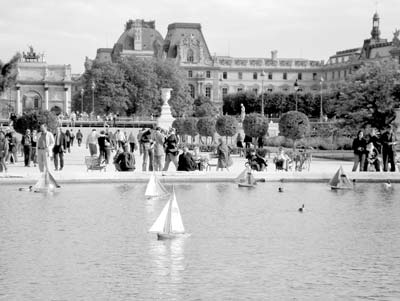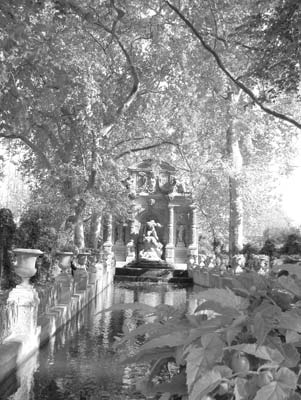Attractions and museums in Paris
I returned to Paris in October ’06 and visited several places of interest.
• Because the Musée de l’Orangerie (Jardin des Tuileries, 75001, Paris, France; phone +33 01 44 77 80 07 or visit www.musee-orangerie.fr) had recently reopened after years of closure due to renovation, attendance was very strong and advance timed-ticketing was recommended.
From the museum’s website, I was able to order tickets from the service FNAC (www.fnacspectacles.com), but I neglected to choose the option of having the tickets mailed to me and instead had to retrieve them from an FNAC outlet in Paris.
I spent too much time on my first afternoon walking to a location near the St. Placide Métro to retrieve the ticket. In hindsight, it was only about a 25-minute walk from my St-Germain area hotel, but it seemed longer because I wasn’t sure where I was going, and then there was the return walk. Once inside the store, there was a line for the billeterie/ticket counter, so that took another half hour or so. I recommend that, if possible, you pay the extra fee for having the tickets mailed to you, even to your hotel.
That said, my visit to the Orangerie after not having been there for many years was a glorious experience. The large, wall-sized Monet water lily panels are as gorgeous as ever, and, if crowds permit, you can sit on a bench and just savor them for as long as you like. Photography without flash is permitted.
• I also visited the Luxembourg Museum (19 rue de Vaugirard, 75006, Paris; phone +33 1 42 34 25 95, fax + 33 1 45 44 57 33 or visit the website, in French, www.museeduluxembourg.fr) where, under the auspices of the Sénat, temporary exhibits are presented.
When an exhibit is on, the museum is open every day, including all holidays. On Sundays and holidays, it’s open 9 a.m. to 7 p.m.; other days it opens at 11 a.m., with varying closing times.
During my visit, the museum was presenting a wonderful exhibit of portraits by Titian and some of his contemporaries. I’d not been aware of the exhibit before my arrival in Paris and so didn’t have an advance timed ticket. Every day that I walked by, the entrance lines were long.
• One afternoon I had a lovely stroll through the sunny Luxembourg Gardens, and when I peeked at the no-reservations line there were only a few people. I waited about 10 minutes and then got in! I was very happy about that. The exhibit I saw ended on Jan. 21, to be followed by one on the work of René Lalique going through July 29, ’07.
• This was the first trip to Paris that I’ve taken that did not include the Louvre, the Musée d’Orsay or the Musée Marmottan. My time was short and I went this time without much of an agenda, therefore I had the pleasure of doing some wandering for the sheer pleasure of discovering, or reacquainting myself with, some places in Paris I’d either never seen or had forgotten.
Here’s one gem I’d never been to: Cour de Rohon, or Rohon Courtyard (www.insecula.com/salle/MS02023.html), in the sixth arrondissement. Take rue Saint-Andre des Arts to rue de l’Eperon, then make a right into rue du Jardinet.
A charming private and small courtyard (actually, three courtyards), it is open for quiet visits. These buildings and courts, with walls draped with flowering vines, date from the 16th century.
• I also visited the Holocaust (Shoah) Museum, with its Memorial of the Unknown Jewish Martyr (17 rue Geoffroy-l’Asnier, 75004 Paris; www.memorialdelashoah.org); take Métro St. Paul or Pont Marie. This Holocaust museum includes a wall engraved with the names of 76,000 Jewish deportees from France. Closed Saturdays, it is open other days 10-9 and Thursdays 10-10.
• Behind Notre Dame is a park dedicated to Pope John XXIII. Behind that park (you’re crossing a road) is the Deportation Memorial (www.paris.org/Monuments/Martyrs.Deportation/info.html) to all French people who were deported to concentration camps during World War II. It is reached via a steep staircase.
Each individual is represented by a crystal — a total of approximately 200,000 of them — and in the center is a tomb for an unknown victim. The memorial closes for lunch from noon to 2 p.m.
• I also made a first visit to the Saint-Denis Basilica, after a strong recommendation from dear friends of mine. I’m so glad I went! It is said to be the “earliest” monumental example of the Gothic style of architecture, but I read about a lot of Gothic “firsts.”
Starting with the Capetian dynasty, it became the burial place of the monarchs of France (visit www.findagrave.com, click on “Search for a cemetery” and type St. Denis in the search box). It has more than 70 carved tombs (including one for Marie Antoinette, though whether or not her remains are actually there is questionable) and many other monuments.
Admission to the royal crypt is included in the Paris museum pass. There are guided tours but only in French. It is open all year except for some state holidays. There is an audio guide available.
To get there, take Métro line 13 and get off at Saint-Denis Basilica (the end of that Métro line is another Saint-Denis station, but you want the Basilica stop). The basilica is a 2-minute walk from the Métro stop, and there are clear signs; you can’t get lost.
• Here’s a place I hadn’t been to in years: Musée du Moyen Age (6 place Paul-Painleve, 75005, Paris; phone 33 [0] 1 53 73 78 00 or visit www.musee-moyenage.fr). This National Museum of the Middle Ages is usually called the Cluny Museum. The building itself is from the 15th century and was a cloister.
Among many tapestries is a series of six large, fabulous tapestries called “The Lady and the Unicorn.” They date from the end of the 15th century and are intact and still brilliantly colored. Photography without flash is permitted.
Closed Tuesdays, the museum has other artifacts as well as a pretty garden. You can also see Roman thermal baths dating to A.D. 200.
ELAINE LAVINE
New York, NY


